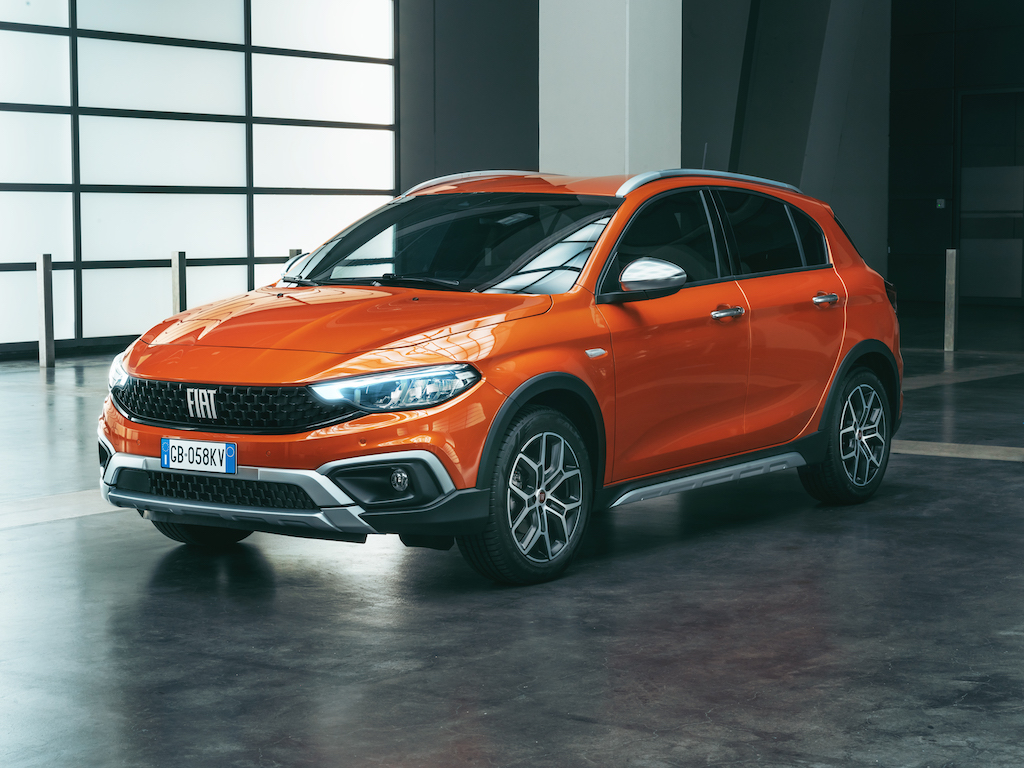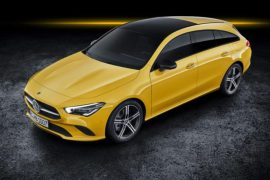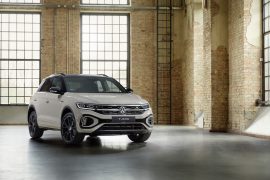The Fiat Tipo was originally launched in 1988, and quickly made a name for itself by being boxy and practical, and affordable to buy.This facelifted model was launched in 2020, along with a new variant – the Cross – which aims to add SUV-like appearances to this otherwise anonymous car!

Even it isn’t the most attractive vehicle in the world, nor does it make you go “wow” when you look at it. But the Cross has nice enough looks to be competitive.
The front has a wide but reasonably thin, horizontal grille that spans the car’s width, bar the room needed for the headlights. Next, add some ‘n-shaped’ bodywork in a different colour to accentuate the SUV styling elements. Then, ‘umbrella’ it over the smaller lower-grille and add a couple of fog lights, and you have a decent-looking car that appears to have modest off-road capabilities.

Down the side of the Fiat, there is a crease that goes through the centre of the door handles. Then there is an indentation in the lower part of the doors, while more protrusions – roof rails and a rugged, patterned scuff-plate side skirt – add strength to its SUV credentials.
The back of the Tipo Cross is less successful but blends a roof spoiler over the rear windows with a thick, meaty rear bumper. Two taillights shaped like bicycle seats extend from the side towards the middle of the boot lid, with more SUV-styled trim along the bottom.
These different coloured off-road-like strips (silver on our test car) give more appeal to the ever-increasing number of SUV customers out there. For a little car, it is pretty stocky, but without losing some sense that it has got at least a bit of athleticism in its arsenal.
There is only one trim on offer. You see, technically, the Cross is one of the standard Tipo hatchback’s trims, sitting alongside the entry-level City Life trim and the top-of-the-range Red trim (the latter of which is curiously written in brackets).
No matter, though, because the amount of kit you get as standard with the Cross will make you feel like you got the top-of-the-range one anyway.

You get 17-inch alloys, a seven-inch touchscreen infotainment system with SatNav and Bluetooth, a DAB radio, and USB slots in the front and back. The Italian-made car also houses a seven-inch digital instrument display, adaptive cruise control, climate control, and automatic high beam. On top of that, there are electrically adjustable heated door mirrors, LED headlights, a speed limiter, start-stop, a premium wrapped steering wheel and dark-tinted rear windows. Then, there is the SUV styling with roof bars, side skirts, front and rear skid plates and black wheel arches.

The Fiat’s cabin is laid out well in terms of style. The air vents look a bit yesteryear, as do the dials for the air conditioning. Not as much has been done inside to set this more lifestyle-orientated version apart from humbler Tipo models. So as with those, you get a 7-inch central touchscreen and a 7-inch full-colour digital instrument cluster screen too. Hard plastics dominate around the cabin but there’s a pleasingly styled 3-spoke wheel and automatic climate control.
The Fiat’s front seats are very comfortable, and there is plenty of movement in the steering wheel and driver’s seat. This means finding an optimal driving position is straightforward, while adjustable lumbar support is also standard.
The rear seats are reasonably spacious, too, given it is a small car. There is a lot of leg and headroom, helped by the fact that the roofline doesn’t slope down all that much.

The boot is also extremely generous with a capacity of 440-litres, which is more significant than its hatchback rivals.
Obviously, this Cross model’s SUV demeanour is only for show; even light trails are really beyond its remit… There’s a reasonable choice of engines.
This Cross variant can be had with the 100hp 1.0-litre unit that must satisfy other Tipo customers. This comes only with manual transmission but rather has its work cut out propelling a family hatch of this size along, though the performance figures aren’t too far off the class norm – rest to 100km/h in 11.8s en route to 119mph.
The alternative Hybrid 48V variant’s 1.5-litre unit puts out 130hp and 240Nm of torque (rest to 100km/h in 9.3s) and is mated to a 7-speed dual-clutch auto transmission. The propulsion system includes a built-in 48 volt 15kW (20hp) electric motor delivering 55Nm of torque, which can propel the wheels even when the internal combustion engine is turned off.
The six-speed manual feels like it’s made of rubber and lubricated with plasticine, but if anything that just lets you crash the gears in quicker and keep up with Brussels traffic smartly.
Whatever your choice of engine, you’ll find that the Tipo’s roadgoing demeanour has been set up to favour relaxed comfort rather than any kind of dynamic drive. You can see why: this is, after all, a car designed primarily around the needs of buyers in developing countries who simply want to get comfortably from A to B.
There are two driving modes – Normal and City – which affect the steering. City makes the wheel feel lighter, suitable for changing direction around town centres and parking. Meanwhile, Normal feels slightly heavier. The lack of a Sport mode says it all, though – competitors certainly offer more enthusiastic handling.
There aren’t masses of small hatchbacks that have been given the SUV treatment – usually, the SUV crossovers are a tad bigger. Despite the engine’s petite size, it is well optimised, decent for short-distance driving, and it handles relatively well. And, for a small vehicle, it is spacious and practical, comes exceptionally well-equipped as standard and has a decent look to the interior.





